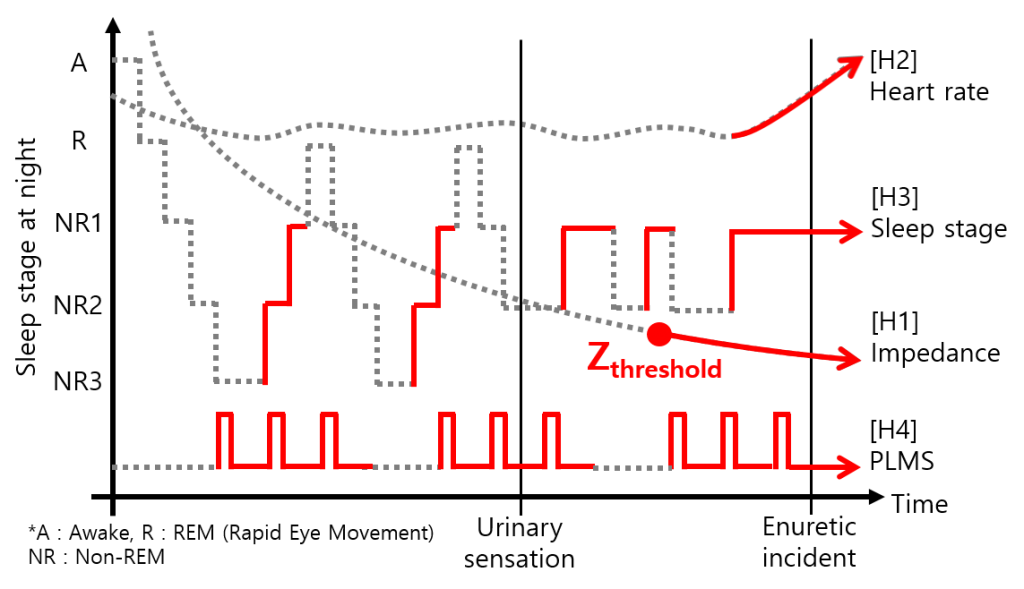Background
The nocturnal enuresis is a pediatric disorder which causes involuntary voiding during sleep without any physical problems. Approximately 20\% of the 5-year-old population have suffered from this disorder [1]. This disorder negatively affects both the children and their parents in terms of psychology, behavior, and even finance [2]. Further, the nocturnal enuresis has become a more serious problem, since number of children who participate in social activities like group camping is gradually increasing.
Common methods for managing the nocturnal enuresis are training the bladder, taking the desmopressin, and using the enuresis alarm. Overall, the conventional therapies differ in the cure rate and impractically manage pain and burdens of patients and their parents [3 ~ 6]. In addition, they cannot prevent the enuresis occurrence. On the other hand, estimating the enuretic moment in advance can be utilized to prevent the occurrence at high cure rate. Further, this approach minimizes pharmacological and behavioral interventions and reduces burdens of family. Unfortunately there have been few approaches to estimate the enuresis before it happens.
Nocturnal enuresis estimation based on physiological data
We have comprehensively investigated various physiological signals and symptoms related to the nocturnal enuresis [7 ~ 10]. Based on the in-depth study, we have reached four hypotheses to estimate the enuresis occurrence, regarding bladder urinary volume, heart rate, sleep stage, and periodic limb movement in sleep (PLMS).

Figure 1 : Interesting hypotheses to estimate the enuretic incident based on physiological data
- H1 : Before the enuretic moment, the impedance values show a gradual decrease due to production of the urine
- H2 : The exceptional increase of the heart rate occurs between the moment of appearing the urinary sensation and the enuretic moment
- H3: The enuretic incident happens after the sleep stage transition from one to closer to the arousal state.
- H4: PLMS(periodic limb movement in sleep) strongly correlates with the nocturnal enuresis
In order to demonstrate hypotheses in both accurate and convenient manner, we have been designing and developing a belt-type device ABDOMEN of multi-modal signals based on Samsung bioprocessor. ABDOMEN represents Advanced Bioprocessor-based Device Of Multi-modal ENsemble signals. Seungchul Shin is the main researcher for designing and implementing ABDOMEN. This is ongoing work and we are preparing several papers for challenging venues regarding this research. Based on our study, we expect a machine learning-based estimation system to prevent the enuresis occurrence shown in Figure 2.

Figure 2 : Structural framework of machine learning-based study for the nocturnal enuresis
For this project, our group is collaborating with urology and electrical engineering departments. Our work will finish the comprehensive framework for the promising estimation of the enuretic moment. The complete framework can help collect the interesting physiological signals during sleep, demonstrate the hypotheses and their relations to the nocturnal enuresis, and estimate when the enuretic incident occurs in advance. Finally, the estimation using the proposed framework will contribute to solve the nocturnal enuresis problem.
Reference
- [1] JP Nørgaard et al. Experience and current status of research into the pathophysiology of nocturnal enuresis. British Journal of Urology, 1997.
- [2] TWJ Schulpen. The burden of nocturnal enuresis. Acta Paediatrica, 1997.
- [3] Leonard S Harris and Arjun P Purohit. Bladder training and enuresis: a controlled trial. Behaviour Research and Therapy, 1977.
- [4] Robert A Pretlow. Treatment of nocturnal enuresis with an ultrasound bladder volume controlled alarm device. The Journal of Urology, 1999.
- [5] Cem Akbal et al. Intermittent oral desmopressin therapy for monosymptomatic primary nocturnal enuresis. The Journal of Urology, 2004.
- [6] WL Robson and AK Leung. Side effects and complications of treatment with desmopressin for enuresis. Journal of the National Medical Association, 1994.
- [7] Rihui Li et al. Preliminary study of assessing bladder urinary volume using electrical impedance tomography. Journal of Medical and Biological Engineering, 2016.
- [8] Anne Kruse et al. Increased nocturnal blood pressure in enuretic children with polyuria. The Journal of Urology, 2009.
- [9] A Kawauchi et al. Changes in the structure of sleep spindles and delta waves on electroencephalography in patients with nocturnal enuresis. British Journal of Urology, 1998.
- [10] KARLIEN Dhondt et al. Sleep fragmentation and increased periodic limb movements are more common in children with nocturnal enuresis. Acta Paediatrica, 2014.
Relevant Publications
- Seung-chul Shin, Sangyeop Lee, Taeho Lee, Kyoungwoo Lee, Yong Seung Lee, Hong-Goo Kang “Two Electrode based Healthcare Device for Continuously Monitoring ECG and BIA Signals“, 2018 IEEE Conference on Biomedical and Health Informatics (BHI)
- Sangyeop Lee, Junhyung Moon, Taeho Lee, Saewon Kye, Seung-chul Shin, Kyoungwoo Lee, “Sleep Stage Classification for Managing Nocturnal Enuresis through Effective Configuration “, 2017 IEEE International Conference on Systems, Man, and Cybernetics (SMC)
- Saewon Kye, Junhyung Moon, Seung-chul Shin, Sangyeop Lee, Taeho Lee, Kyoungwoo Lee, “Detecting Periodic Limb Movements in Sleep using Motion Sensor Embedded Wearable Band”,2017 IEEE International Conference on Systems, Man, and Cybernetics (SMC)
- Seung-chul Shine, Junhyung Moon, Saewon Kye, Kyoungwoo Lee, Yong Seung Lee, Hong-Goo Kang, “Continuous Bladder Volume Monitoring System for Wearable Applications”, IEEE 39th Annual International Conference of the Engineering in Medicine and Biology Society (EMBC)
- Junhyung Moon, Sangyeop Lee, Taeho Lee, Saewon Kye, Yong Seung Lee, Seung-chul Shin, and Kyoungwoo Lee. “A Prospective Study of Examining Physiological Signals for Estimating Occurrence of Nocturnal Enuresis.”, 2017 IEEE 39th Annual International Conference of the Engineering in Medicine and Biology Society (EMBC)
Research funding
- “ICT-based integrated diagnosis solution and personalized treatment for nocturnal enuresis”
- National Research Foundation of Korea(NRF) grant funded by the Korea government(MSIP; Ministry of Science, ICT & Future Planning)
- 23K USD (2018)
- “Deep learning-based prediction system for nocturnal enuresis with multimodal biometric data (No.2017R1C1B5018075)”
- National Research Foundation of Korea(NRF) grant funded by the Korea government(MSIP; Ministry of Science, ICT & Future Planning)
- 80K USD (2017~2020)